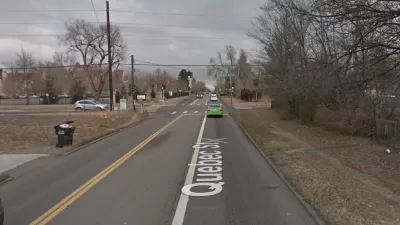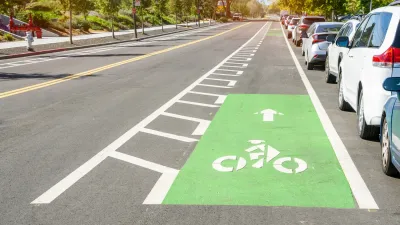The Denveright plan puts pedestrians first, but could do more for public transportation and bikes, says a critique from Streetsblog Denver.

A new Streetsblog Denver series unpacks the implications of Denveright, the recently released suite of plans that together form a comprehensive vision for the city's future growth. The piece of the new package guiding land use and transportation for the next 20 years is Blueprint Denver—and at this stage, it's receiving mixed reviews from writer David Sachs.
Blueprint's revamped framework for street design calls for every street in the city to prioritize walking over other modes of transportation, and explicitly acknowledges the trade-offs that will require, like slowing vehicle speeds and reducing street parking. But it stops short of adopting a full complete streets policy by not extending public transit or bicycle infrastructure throughout the city. Sachs reports:
City planners opted against recommending a "complete streets" policy, a simple directive that compels planners and engineers to favor pedestrians, bicyclists, transit riders, and cars — in that order — on every street … Instead, Blueprint creates a more complex “modal priority” network [PDF]. Maps identify where walking should dominate (all streets), where biking is the street’s main function, and where transit is the priority. Some streets will prioritize all three modes.
As Sachs points out, many of the corridors projected to absorb a large share of new population and job growth were among those not chosen to receive bike infrastructure.
FULL STORY: Denver’s New Blueprint for Growth Puts Peds First, But Every Street Won’t Be “Complete”

Planetizen Federal Action Tracker
A weekly monitor of how Trump’s orders and actions are impacting planners and planning in America.

Congressman Proposes Bill to Rename DC Metro “Trump Train”
The Make Autorail Great Again Act would withhold federal funding to the system until the Washington Metropolitan Area Transit Authority (WMATA), rebrands as the Washington Metropolitan Authority for Greater Access (WMAGA).

The Simple Legislative Tool Transforming Vacant Downtowns
In California, Michigan and Georgia, an easy win is bringing dollars — and delight — back to city centers.

The States Losing Rural Delivery Rooms at an Alarming Pace
In some states, as few as 9% of rural hospitals still deliver babies. As a result, rising pre-term births, no adequate pre-term care and "harrowing" close calls are a growing reality.

The Small South Asian Republic Going all in on EVs
Thanks to one simple policy change less than five years ago, 65% of new cars in this Himalayan country are now electric.

DC Backpedals on Bike Lane Protection, Swaps Barriers for Paint
Citing aesthetic concerns, the city is removing the concrete barriers and flexposts that once separated Arizona Avenue cyclists from motor vehicles.
Urban Design for Planners 1: Software Tools
This six-course series explores essential urban design concepts using open source software and equips planners with the tools they need to participate fully in the urban design process.
Planning for Universal Design
Learn the tools for implementing Universal Design in planning regulations.
Smith Gee Studio
City of Charlotte
City of Camden Redevelopment Agency
City of Astoria
Transportation Research & Education Center (TREC) at Portland State University
US High Speed Rail Association
City of Camden Redevelopment Agency
Municipality of Princeton (NJ)





























